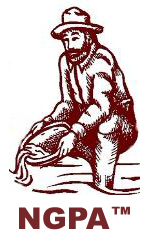The Search for Lost Treasure: Finding Buried Gold

It was the most concentrated and prolonged search for lost treasure in the history of North America. It didn’t take place on Oak Island, or at the bottom of the blue Caribbean, or even in the scorpion and rattlesnake infested deserts of the southwest. Rather, it occurred at the foot of the Green Mountains, near the village of Bristol, Vermont.
From 1840 to 1850, a French Canadian named Simeon Coreser headed a hard-core cadre of a dozen or more of his fellow countrymen and scores of local citizens, who combed the rocky wasteland known to this day as Hell’s Half Acre. Every boulderno matter the weight or size that might conceal an opening to the center of the mountain was moved, and then the cavern resolutely searched. In the more accessible spots, a rope was tied around the ankles of a somewhat reluctant volunteer, who was lowered headfirst into the midnight blackness of the unknown. While the volunteer changed from time to time, the end result never differed in the ten years the Canadian poured his entire personal fortune into the quest. Balked by frequent slides, as well as the opposition of many of the area’s residents, Coreser “hung in there” until his last dollar was gone. A broken and defeated man, the Frenchman returned to his native Canada and never again visited the Green Mountains.
In the century and a quarter since Coreser abandoned his search, Hell’s Half Acre has seen frequent visitors bent on finding a fortune. The jumbled pile of stones are pitted and pockmarked with the futile efforts of hundredsnone of whom had the “stick-to-itiveness” of the courageous Canadian.

Between May and October, automobiles with out-of-state licenses are often seen making the turn from Main Street, past the lumberyard, through the dark tunnel-like forest, and up the tortuous road which flanks the sometimes rampaging creek. The narrow canyon is often converted into a miniature replica of Niagara gorge. The “diggins” is no place for softies.
No doubt the story of the lost silver of the Green Mountains has been colored with the passing of time. Many Vermonters don’t believe the story at all, although some are not aware of Coreser’s lengthy pursuit of the wealth he believed to be beyond the wildest dreams of an Indian maharajah.
Bristol, then named Pocock, was but 14 years old in 1800 when Pedro De Grau, a French Basque (some say Spanish), appeared on the scene. Suspicious of all strangers, particularly those from Canada, the town’s citizens watched the strange actions of the visitor. He would stare for hours at the face of the mountain, then clamber among the great boulders, obviously in search of something very precious to him. He often commented to the villagers on how the face of the mountain had changed since he had seen it many years earlier.
Pinned down by the curious, who had become somewhat annoyed at the odd behavior of their visitor, De Grau finally related a tale that left his audience fascinated.
In the years before the war between England and France (1754-1761) De Grau, along with his father and several others, had visited the region on a hunting expedition. By accident the party had stumbled upon a tremendous vein of silver. The find was on the inside wall of a cave; the entrance faced the setting sun. Large amounts of the ore were melted down by the men and run into sand molds to create bars. They stacked tier upon tier against the wall inside the cave. Relations between England and France were worsening, there was ever present danger of Indian attack, and the men had no way to remove more than a fraction of their new found wealth. There was also the possibility the treasure would be confiscated as contraband of war. So they decided on a course of action: Rolling a stone in front of the cave to seal the opening. The men then headed for Canada, planning to return with enough horses and oxen to transport the heavy bars.
It was almost half a century before De Grau, now an elderly man, returned to the site of the rich discovery. Time and war had eliminated all of his partners. Meanwhile, a tremendous landslide had destroyed or effaced all identifying landmarks. However, De Grau was positive he was on the right track. All he had to do was to find the buried cave.
The Basque’s story fueled an epidemic of treasure hunting such as New England has never seen since. Hundreds of people combed the rocky slopes, which changed in shape with each passing season. None ever saw a sign of silver. While many scoffed at the existence of silver anywhere in Vermont, there was the puzzling fact that Indians were known to wear silver adornments.
Then Coreser arrived, fortified with reams of research and testimony, and a knowledge of excavation that would make an engineer blush with envy. Since then hundreds have had a go at the diggins, and just as many stuck it out.
Today, Hell’s Half Acre is something else. Viewed from the front porch of the Bristol Motor Inn, the face of the mountain is bare in the area where De Grau claimed the loot was buried. It is as difficult to pinpoint as the mountains on the moon.
The gloomy site of the silver diggins has foliage as dense as the Matto Gross but the species are different. Frost grapes, fox grapes, virgin’s bower, red vine, sumac, choke cherry and turtle heads create a camouflage net, hiding thousands of tremendous boulders from view. The solitude of the almost midnight darkness can make a treasure hunter uneasy. The babble of an underground brook on its way to union with the roaring creek at the bottom of the mountain is about all that one can hear, except perhaps for the flapping wings of a startled owl. Crevices, small caverns, and the diggings of treasure hunters long gone to their reward give the impression of being on the moon. Underfoot are millions of tiny pebbles, hazardous to walk on and creating the illusion of tramping on marbles.
Don’t search Hell’s Half Acre alone, and don’t go in without the proper equipment. In addition to rattlesnakes, the danger of a broken leg or worse is present. It’s best to know something about hiking and prospecting before you try this, and to keep in mind that silver has never been found anywhere in Vermont. The story of the “Spanish diggins” has become a popular Vermont legend, and visitors to Bristol are often regaled with the saga of the resolute Coreser. It has been suggested, however, that the real treasure is the beauty of the area; the gorgeous falls just above the village, the vast array of wildflowers, the myriad animal and birdlife, and the healthy, smog-free air. Some Vermonters also mention the ancient Indian village at Bristol Pond where a number of authentic artifacts have been found over the years. Spear, axe and arrowheads, many incomplete, give proof that the site was a permanent village. A number of years back the skeletal remains of two Indians in a sitting position were discovered near the pond.
Truth or fantasy? The answer to the mystery of De Grau’s story lies somewhere in the mountains. The incident could have occurred. And there’s the still nagging question of why Simeon Coreser poured so much time and money into his disappointing quest. If you decide to look for the answers, don’t forget at least to stop and smell the flowers.

